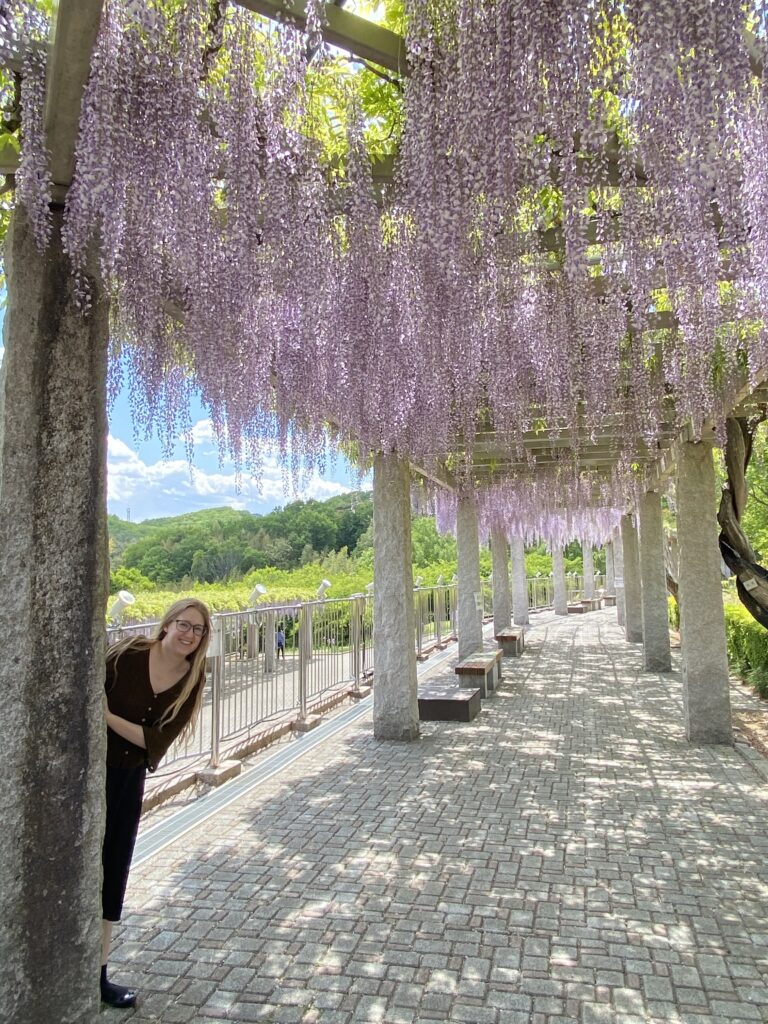A Dangling Floral Canopy
Japanese wisteria are truly a wondrous sight to behold. Walking through those dizzying canopies of dangling blossoms really makes you feel like you’re wandering into a magical, new realm.
Wisteria flowers (or purple bananas, as my friend Jodie likes to say 😉) are called fuji no hana (藤の花) in Japan. They tend to start blooming around late April and early May, overlapping with the end of cherry blossom season. Unlike cherry blossoms, though, wisteria give off a distinct fragrance that cloaks the area in a sweet perfume.
Since wisteria is a climbing vine, you will usually find its flowers dangling from rooftops, trellises, trees, and basically anything it can twist itself around. Violet is one of the more common colors, but you may also see white, pink, and blue varieties depending on where you go.
When cultivated, Japanese wisteria vines usually produce flowers every year. If you live in a mountainous area (like me), you can even catch glimpses of it just hanging out in the wilderness. Apparently, this wild wisteria only tends to flower every few years, so it’s a bit of a rarer find.
Luckily for me, both types happened to be blooming during my second year in Japan, so I was able to catch both the cultivated and mountain varieties as they colored the landscape in a deep, purple haze. 🙂
The Symbolism of Wisteria
Wisteria has come to symbolize many ideas across a variety of cultures. In Japan, the flower has adopted some interesting representations that have changed throughout history.
Longevity and Immortality: Lifelong Blossoms
Because of their lengthy lifespan and hardy nature, wisteria are seen as a symbol for longevity. A marvelous real-world example of these long-living plants can be found in Tokaen Park in Saitama Prefecture. The Ushijima Wisteria growing there are over 1200 years old!
With such an incredible potential for long life, the flowering vines have even been regarded as symbols of infinity and immortality. Since they have the ability to outlast 12 human lifetimes (and counting), it’s easy to see why these plants are so highly regarded.
Nobility and Privilege: Ranking by Color
Throughout Japanese history, wisteria flowers were often recognized as a symbol of nobility due to their purple hues. Historically, members of Japanese society were designated a certain color depending on their class, with purple being the highest rank and grey being the lowest.
Since purple represented the ruling class, only high-ranking officials, monks, and members of the Imperial Family were allowed to wear it. A strict twelve-level ranking system was enforced during the Nara, Heian, and Edo Periods. During this time, commoners were prohibited from wearing purple (or any other color outside their assigned level).
This harsh color-ranking system was eventually done away with in the Meiji Era, so nowadays, people are free to wear whatever colors they want. Purple is still commonly worn among high-ranking Shinto and Buddhist priests, though, so traces of this historical symbolism do remain in Japanese society.
Love and Resilience: The Wisteria Maiden
A dance known as Fuji Musume, the Wisteria Maiden, is a famous performance carried out in kabuki theatres across Japan. The classic dance is about the unrequited love of a woman who resides within a painting at an artists market in Otsu City. She carries with her a wisteria branch, earning her the title of Wisteria Maiden.
One day, as a man stops to gaze at the Wisteria Maiden’s painting, she becomes deeply infatuated with him. The maiden’s love is so strong that she even comes to life, leaving her painting to pursue a relationship with him.
Now among the living, the Wisteria Maiden begins writing heartfelt letters to her love interest. Unfortunately, her passionate advances are completely ignored, and the heartbroken maiden is left to despair beneath a beautiful vine of blooming wisteria. Finally, she gives up on the man and returns to her painting devastated, marking the end of this somber dance.
The maiden’s resilience in the face of her numerous rejections is echoed in the wisteria vine’s natural hardiness and ability to survive in harsh conditions.
Where To Find Wisteria in Japan
If you are in Japan during wisteria season, there’s bound to be a spot near you where you will be able to do some quality flower-viewing. Here are some of my recommendations for the best places to view these flowers in Japan.
1) Fuji no Saku Oka – ふじの咲く丘 (Fujioka City)
The city of Fujioka in Gunma Prefecture is actually named after wisteria flowers! The name is a combination of the kanji for fuji (藤), meaning “wisteria,” and oka (岡), meaning “hill.”
Fuji no Saku Oka is a park located on a looming hill in the heart of the city. It’s a wonderful place for flower viewing, with several paths that bring you up close and personal to the dazzling trellises of swaying blossoms.
As you wander the park, you will see purple, pink, and white clusters of hanging flowers, as well as about 45 different species.
The best time to visit is during late April to early May, where a Fuji Festival celebrating wisteria flowers takes place.
And, if you venture far enough, you might even get the chance to snap a photo with an adorable wisteria-themed Gunma-chan!
2) Ashikaga Flower Park – 足利フラワーパーク (Ashikaga City)
The Ashikaga Flower Park in Tochigi Prefecture is definitely one of the most renowned places for viewing wisteria in Japan. In it, you’ll find mesmerizing tunnels and breathtaking bridges all overflowing with gorgeous blooms.
Throughout this park, you’ll get the chance to see shades of purple, pink, white, and pale red flowers, as well as some rare golden Kibana wisteria.
Some of the most notable attractions are the White Wisteria Trellis Bridge, the Great Wisteria Tree, and a famous tunnel of Kibana blossoms.
You can also visit the park’s attractions after dark, where vibrant illuminations light up the night and create mesmerizing silhouettes in the surrounding flowers.
3) The Ushijima Wisteria of Tokaen – 藤花園の牛島の藤 (Kasukabe City)
The Tokaen garden in Kasukabe City, Saitama Prefecture, is home to a famous collection of Ushijima Wisteria. It is especially renowned for cultivating the world’s oldest wisteria vines, which have been growing there for over 1200 years. Some of the lilac clusters throughout the park even reach up to two meters in length!
Legend has it that the Ushijima Wisteria were first planted there by Kobo Daishi, the founder of the esoteric Shingon school of Buddhism. Kobo Daishi lived during the years of 774-835, so the timeline does fit the legend. 😀
Another interesting feature that sets Ushijima Wisteria apart from other varieties is that the vines actually twist clockwise instead of counter-clockwise.
These ancient vines have been officially designated as a national treasure in Japan and are definitely worth the trip into Saitama.
4) Kawachi Fujien – 河内藤園 (Kitakyushu City)
You’ll find this spectacular wisteria garden in Kitakyushu City, Fukuoka Prefecture. It is particularly famous for its colorful, arching domes that feature drooping blossoms of alternating pink, white, and violet layers. Meandering through these dreamy passages of swaying wisteria is a peaceful and almost other-worldly experience.
And, you can even come back to the park in fall to catch a great view Japanese maple leaves as they transform the landscape into an autumn wonderland.
Wisteria in the World of Kimetsu no Yaiba
If you’ve ever seen or read Kimetsu no Yaiba (also known as Demon Slayer), then you may already be somewhat acquainted with wisteria flowers. Actually, that was how I discovered these captivating flowers for the first time—when my students finally convinced me to watch the anime (and now I’m hooked).
The Story: A Quick Summary
Kimetsu no Yaiba is set in the past and takes place in Japan during the Taisho era (around the years 1912-1926). It’s an incredibly moving story that revolves around Tanjirou Kamado, the kind-hearted protagonist with a scar on his forehead and a keen sense of smell.
One snowy, winter evening, while Tanjirou is away buying charcoal, his family is attacked by a demon. Tanjirou returns to find that his older sister Nezuko, the sole survivor of the tragic attack, has been transformed into a demon herself. The rest of the story follows Tanjirou on his perilous journey to slay demons, avenge his family, and turn his sister back into a human.
The Fanciful Role of Wisteria
In the fictional world of Kimetsu no Yaiba, wisteria have some very special properties that make them super useful for demon slayers. Without going into too many details (spoilers, am I right?), the flowers basically act as a demon repellant capable of trapping, poisoning, or warding off demons. They are a crucial element in the overarching plot and play an essential role in the story’s resolution.
A scene taking place on Mt. Fujikasane vividly captures an enchanting forest of dangling wisteria that stretches for miles. These flowers were so beautiful and mysterious to me that I actually thought they were made up, existing only within the realm of imagination. It wasn’t until much later that I found out the series had simply adapted a real flower species known throughout all of Japan.
So, if an emotional tale involving epic characters, intense battles, familial love, and mesmerizing floral scenery appeals to you, hop on over to Netflix and give Kimetsu a try. 😛
Take A Stroll Down Wisteria Lane
Ever dreamed of wandering into a magical new world? If so, you should definitely take a stroll through a Japanese garden during wisteria season. And, if you’re lucky, you may even get the chance to see some wild, mountain wisteria peeking through the trees as you travel around Japan.



























